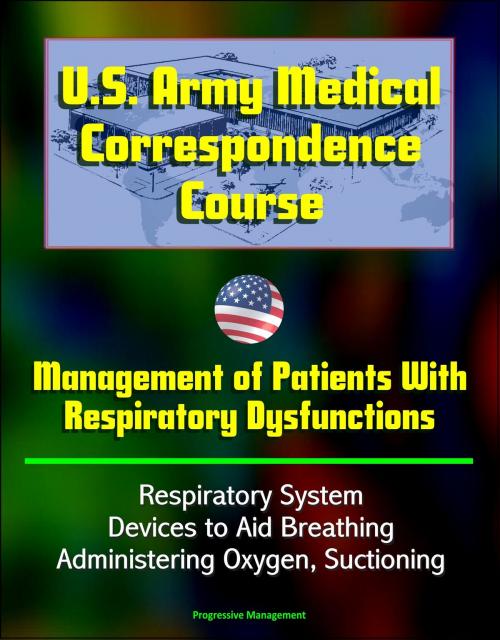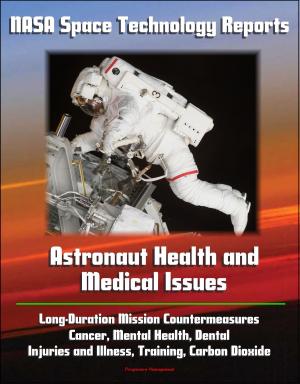U.S. Army Medical Correspondence Course: Management of Patients With Respiratory Dysfunctions - Respiratory System, Devices to Aid Breathing, Administering Oxygen, Suctioning
Nonfiction, Health & Well Being, Health, Ailments & Diseases, Respiratory, Medical, Nursing, Critical & Intensive Care| Author: | Progressive Management | ISBN: | 9781311357113 |
| Publisher: | Progressive Management | Publication: | October 14, 2014 |
| Imprint: | Smashwords Edition | Language: | English |
| Author: | Progressive Management |
| ISBN: | 9781311357113 |
| Publisher: | Progressive Management |
| Publication: | October 14, 2014 |
| Imprint: | Smashwords Edition |
| Language: | English |
This subcourse presents a review of the respiratory system, devices such as the oralpharyngeal airway and bag-valve-mask (BVM) systems which are used to assist a patient's breathing efforts, procedures for supplying the patient with additional oxygen through the use of the face mask and nasal prongs, and procedures for removing secretions interfering with breathing through the use of suction.
This subcourse is approved for resident and correspondence course instruction. It reflects the current thought of the Academy of Health Sciences and conforms to printed Department of the Army doctrine as closely as currently possible.
LESSON 1 - THE RESPIRATORY SYSTEM * Exercises * LESSON 2 - DEVICES USED TO AID BREATHING * Exercises * LESSON 3 - ADMINISTERING OXYGEN * Exercises * LESSON 4 - ORAL, NASOPHARYNGEAL, AND NASOTRACHEAL SUCTIONING * Exercises
The cells of the body require a constant supply of oxygen to carry on the chemical processes necessary to life. As a result of these processes, carbon dioxide (a waste product) is formed and must be removed from the body so that the cells do not become poisoned by their own wastes. Oxygen and carbon dioxide are continuously being exchanged, both between the body and the atmosphere and within the body, by the physiological process known as respiration. The system that performs the exchange of gases between the body and the atmosphere is the respiratory system.
There are two types of respiration--external and internal. External respiration is the exchange of gases between the air in the lungs and blood. Internal respiration is the exchange of gases between the blood and the individual cells of the body.
Breathing is the mechanical process that moves air into and out of the lungs. There are two types of breathing in humans--costal (thoracic) and diaphragmatic (abdominal). In costal breathing, the major structure causing the movement of the air is the rib cage. In diaphragmatic breathing, the diaphragm causes the air to move into and out of the lungs.
This subcourse presents a review of the respiratory system, devices such as the oralpharyngeal airway and bag-valve-mask (BVM) systems which are used to assist a patient's breathing efforts, procedures for supplying the patient with additional oxygen through the use of the face mask and nasal prongs, and procedures for removing secretions interfering with breathing through the use of suction.
This subcourse is approved for resident and correspondence course instruction. It reflects the current thought of the Academy of Health Sciences and conforms to printed Department of the Army doctrine as closely as currently possible.
LESSON 1 - THE RESPIRATORY SYSTEM * Exercises * LESSON 2 - DEVICES USED TO AID BREATHING * Exercises * LESSON 3 - ADMINISTERING OXYGEN * Exercises * LESSON 4 - ORAL, NASOPHARYNGEAL, AND NASOTRACHEAL SUCTIONING * Exercises
The cells of the body require a constant supply of oxygen to carry on the chemical processes necessary to life. As a result of these processes, carbon dioxide (a waste product) is formed and must be removed from the body so that the cells do not become poisoned by their own wastes. Oxygen and carbon dioxide are continuously being exchanged, both between the body and the atmosphere and within the body, by the physiological process known as respiration. The system that performs the exchange of gases between the body and the atmosphere is the respiratory system.
There are two types of respiration--external and internal. External respiration is the exchange of gases between the air in the lungs and blood. Internal respiration is the exchange of gases between the blood and the individual cells of the body.
Breathing is the mechanical process that moves air into and out of the lungs. There are two types of breathing in humans--costal (thoracic) and diaphragmatic (abdominal). In costal breathing, the major structure causing the movement of the air is the rib cage. In diaphragmatic breathing, the diaphragm causes the air to move into and out of the lungs.















